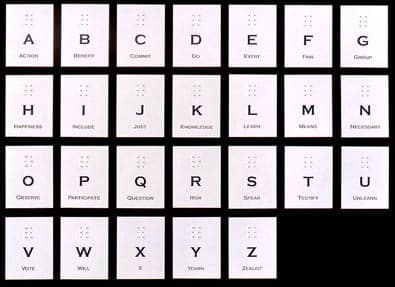by Jennifer L. Pozner
Media literacy is our strongest tool against propaganda and manipulation in today’s media-saturated environment. As someone who analyzes the media regularly, I created a 13-letter mnemonic of the words “M.E.D.I.A. L.I.T.E.R.A.C.Y.” It’s my guide to understanding the goals of corporate media, breaking down its biases and arming ourselves as consumers.
M.E.D.I.A. — Message, Economics, Debate, Impact, Accuracy
- MESSAGE
The key to becoming media literate is learning to decipher not only what is being said and shown on screen or in print (the “text,” or overt surface message, whether an episode of America’s Next Top Model or a New York Times article on immigration) but also to deconstruct the meaning of underlying media messages (the “subtext”). What is the primary message—the “frame”—of the news report, TV show or music video you’re seeing?

A reality TV modeling show sponsored by fashion and beauty product placement gives subtext about girls’ and women’s bodies, and their value as people. A news column on Arizona’s recent anti-immigration bill that only focuses on legal precedents without featuring any direct quotes from immigrants or immigrants’ rights advocates obscures the policy’s implications on those most affected.
Ask yourself: What narrative messages did the editors or producers decide are central to the story? How is the story framed to support that narrative? What does the story encourage you to believe about women and men, people of color and white people, wealthy and low-income people, heterosexuals and lesbian, gay, bisexual and transgender people? What ideas are being normalized? What ideas are being vilified, or ignored?
- ECONOMICS
Follow the money. Wonder why news outlets regularly demonize low-income mothers who need small sums of public assistance to feed their children, yet very rarely report on the billions in corporate welfare (tax breaks, incentives, bailouts) raked in by their parent companies or their advertisers?
The vast majority of American media, including newspapers, magazines, TV, film, music and more, are controlled by six corporations: Disney, Time Warner, News Corp, CBS, Viacom and General Electric (possibly to be replaced by ComCast if the FCC approves their merger with NBC Universal).
Their primary goal of corporate media is not to provide critical, independent information essential to a thriving democracy. Nor are they motivated by a desire to produce compelling, creative or diverse art to enhance our culture.
Their mission is simply to generate massive profits. This commercial bias colors everything we read, watch and hear in corporate media. Our needs as media consumers, as citizens, take a backseat.
Lindsey Lohan’s relationship woes and Paris Hilton’s panties (or lack thereof) aren’t lead stories because journalists consider their antics newsworthy—it’s all about the math. What’s cheaper: paying for a team of investigative reporters to generate stories, or throwing a few hundred bucks to the paparazzi for footage of some starlet’s meltdown?
- DEBATE
Contrary to the myth of the “liberal media,” the range of public debate is heavily weighted toward the right. As documented by decades of research, women’s voices in general—and strong left and progressive perspectives in particular—are statistically underrepresented in corporate media. The spectrum of news debate includes far-right spokespeople (Fox News host Bill O’Reilly; fundamentalist Christian activist turned news pundit Pat Robertson), conservatives (syndicated anti-feminist columnist Kathleen Parke; Newsweek and Washington Post writer and Sunday morning talk show staple George Will), centrists (representatives from think tanks such as the Brookings Institution and the Council on Foreign Relations), and, less often, liberals (MSNBC host Rachel Maddow; New York Times’ op-ed writer Bob Herbert).
The majority of decision-makers in media are upper-middle-class, straight white men
Corporate gatekeepers rarely allow progressive advocates an authentic voice in our national conversation. Can you name five progressive women—or even just five progressives—with corporate news host, analyst or commentator gigs who are as staunchly pro-feminist and anti-racist as right-wing radio host Rush Limbaugh is about his arch-conservative politics?
How about five progressive advocates of color with prominent corporate media jobs?
Since the majority of decision-makers in media newsrooms, executive suites and corporate boards are upper-middle-class, straight white men, their perspectives serve as filters for news and entertainment content. Race and gender issues account for only one percent of overall news coverage.
According to various studies by Fairness & Accuracy In Reporting, the White House Project and the Annenberg Public Policy Center between 2002 and 2008, women are only 15 percent of nightly news sources, 14 percent of guests on Sunday morning talk shows, and 12 percent of corporate board members and 15 percent of executives at Fortune 1000 media and telecom companies.
People of color face similarly stark under representation within the industry and in media content according to the National Association of Black Journalists.
- IMPACT
When you read a news article, watch a TV show, see a film or look at advertising, how do you feel about yourself? About others? What impact might this media content have on people who engage with it?
Consider media discussions about rape that emphasize victims’ clothing, sexual history and drinking habits. What impact might that have on public perceptions of sexual assault and who is responsible for causing—and preventing—violence against women? What are the public policy implications? How might the impact of media imagery shift depending on the gender, race, class, age, sexual orientation, immigration status or physical ability of the person engaging with this media?
- ACCURACY
With the alarming rise of commentary packaged as reporting, and fact checkers and investigative reporters downsized, journalistic accuracy is a casualty of media consolidation. Cultivate a healthy skepticism regarding polls, statistics and studies quoted in corporate news outlets. Unless from a trusted source (preferably a non-commercial, independent outlet known for solid reporting and reasoned commentary), don’t take broad reports of political, social or scientific studies at face value. If you are interested in the subject, find the original research and read it for yourself. You’ll often find that the headline or the reported tidbits do not match the study’s actual findings. For example, a 2001 London Daily Telegraph story headlined, “Gays Have Mental Illness and Can Be Cured, Doctor Says” was based on a study with no control group, no physiological testing and no evidence of long-term “success”—it also never claimed that homosexuality is a mental illness.
Progressive media monitoring groups such as Women In Media & News, Fairness & Accuracy In Reporting and the Global Media Monitoring Project, magazines such as Extra! and Columbia Journalism Review expose factual inaccuracy and ideological bias.
L.I.T.E.R.A.C.Y. — Language, Inquisitiveness, Tools, Exclusion, Responsiveness, Advertising, Creativity, You

- LANGUAGE
Learn to recognize and unpack coded language. Long-time On The Issues Magazine readers are likely aware of the concerted semantic campaign right-wingers employed in the early 1980s to transition from describing their efforts as “anti-women’s lib” and “anti-abortion” to “pro-family” and “pro-life.” Decoding such spin gets underneath surface rhetoric to hidden agendas masked by right-wing, corporate or government talking points.
Consider the coded legacy of the phrase “welfare queen,” first popularized in Reagan-era media. Then, in the mid-1990s, the Clinton Administration began to dismantle the social safety net by claiming that the “Personal Responsibility and Work Opportunity Reconciliation Act of 1996” legislation would “empower the poor” with workfare to improve self-esteem and their communities, and liberate them from a “victim mentality.” This new, more compassionate-sounding lingo from a Democratic president simply updated the “lazy welfare queen” vitriol of earlier years.
Media commentators described women who needed public assistance as “greedy” for “handouts.” They were said to be “sucking off the public dole,” and were labeled “public enemy number one.” And despite the fact that the average woman on welfare at the time was white, the subjects of welfare stories were predominately women of color. After decades of such media coverage scapegoating poor women, especially young Black and Latina mothers, neither the Clinton Administration nor the journalists who covered welfare reform had to actually say “Lazy Black women are stealing tax dollars from hard working white, middle class Americans.” Their warmer, fuzzier soundbites about “empowerment” carried allusions to the phrase “welfare queen,” and they were able drag in the old bigoted baggage. Clinton’s welfare reform bill passed in 1996, forcing many young women out of college and into dead-end workfare jobs that continued, rather than curbed, the cycle of poverty.
- INQUISITIVENESS
In our mega-merged corporate media environment, it is very possible for each of your local and regional newspapers, TV news stations and radio stations to be owned by the same corporation—and for each of those outlets to utilize the same news frames and echo the same factually inaccurate content. To be a truly informed citizen and to arm yourself against propaganda, you must be inquisitive in your approach to the news. Don’t rely on one source for your information. Turn to multiple print, broadcast and online sources, published and produced by different parent companies. Ideally, get your news from independent, non-commercial magazines, which are listed on the WIMN’s Voices blogroll.
Don’t take broad reports of political, social or scientific studies at face value
- TOOLS OF PERSUASION
The Media Literacy Project offers a 40-point guide to understanding the Language of Persuasion used by media makers, such as straw man arguments, hyperbole and “cause vs. correlation.” Take entertainment TV: what storytelling devices are used to get you to buy into a show’s master narrative? Consider casting, direction, editing, cinematography, music, screen captions. In the case of reality TV, study the voice overs, testimonials, framing of scenes, drama-inducing contests, and the practice of “Frankenbite” editing, by which a person’s comments are pieced together from various different conversations.
- EXCLUSION
Consider the age, gender, ethnicity, appearance, sexual orientation, profession, physical ability/health status, nationality and expressed ideology of the op-ed writers you read, the people quoted in newspaper and magazine stories, the pundits who comment on network or cable news, the actors in movies and scripted TV series, the people cast on network or cable reality shows. Who is excluded from the news, or from starring in TV and film? Who benefits from this exclusion? Would the master narrative shift if a broader set of participants was involved?
- RESPONSIVENESS
Turn the media monologue into a dialogue. Frame the debate on your own terms, and respond when you see coded language being used against your community in news stories, when issues you care about are being misrepresented, or when media ignore the voices of women, people of color, youth, workers or others whose perspectives are important to a story. Write letters to the editor (send them in the mail, as well as online), request an editorial board meeting, organize a protest outside an offending media outlet.
- ADVERTISING
Deconstructing images of women and people of color in advertising is often a rite of feminist passage (as the longevity of Jean Kilbourne’s often-updated Killing Us Softly documentary series, and the popularity of the blog Sociological Images can attest). Analyzing how such images shape perceptions of beauty, power and violence is often the catalyst that motivates young activists in media activism.
But we must go further to investigate the influence of advertising over the content of news and entertainment media. Advertising, a multi billion dollar annual industry, is the foundation of corporate media. The “editorial wall” (journalists and entertainment writers on one side, marketers on the other) has all but disintegrated in the wake of the merger-happy Telecommunications Act of 1996. The entire reality TV genre exists specifically to provide stealth marketers with programming built around their products.

If that’s not bad enough, VNRs (video news releases) from corporate advertisers are packaged to appear interchangeable with actual journalism, and often run without disclosure on broadcast and cable news. That report on the energy crisis touting the virtues of “clean coal,” or that health story extolling the supposed safety of plastic surgery, may well have been written, produced and paid for by the coal industry or by a cosmetic surgery association. Ask who profits from the framing and direction of this news report, TV show, movie or music video? Are products integrated into the show’s scenery, dialogue, contests or plot development? How might casting, show premises and narratives differ if a reality TV series wasn’t built to be a “complementary environment” for showcasing products? Are elements of the “content” of a sitcom, drama or news story similar to the commercials or the ads running next to the magazine piece?
- CREATIVITY
A common mantra in media justice communities is a simple call to action: “Don’t like the media? Be the media!” Are your local news outlets ignoring pressing stories in your community about police abuse, threats of violence against women’s health centers, or environmental pollutants? Do citizen journalism: document the problems, interview community members, check facts with experts, and report the stories online.
Are you tired of TV shows marginalizing actors of color, or casting only young, skinny women? Create the kinds of media options you want to see. New media tools make it cheap and easy to produce, film and distribute alternatives, including video remixes and mash ups. Start your own blog, podcast, online magazine or social networking community. Create counter-ads to parody manipulative commercials. Start a pirate radio station, or produce your own cable access TV show. Distribute your media content via YouTube, Vimeo, Twitter, Facebook, MySpace, SheWrites and other social networking sites.
- YOU
Corporate media have vast financial resources and broad cultural influence. But you have power as well: the power to challenge media bias by thinking critically about media content, production and policy, to promote media literacy among your friends and community, and to demand accountability from media corporations. For more information, see Women In Media & News or MAGNET, the Media Action Grassroots Network.
Jennifer L. Pozner is founder and Executive Director of Women In Media & News. She conducts media literacy and education programs for schools and social justice groups. Her first book, Reality Bites Back: The Troubling Truth About Guilty Pleasure TV, will be published by Seal Press in Fall 2010.
